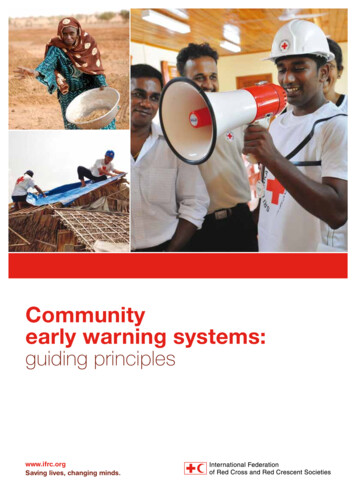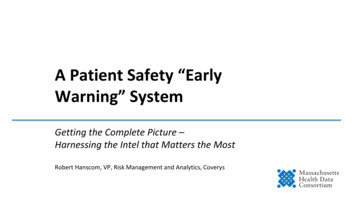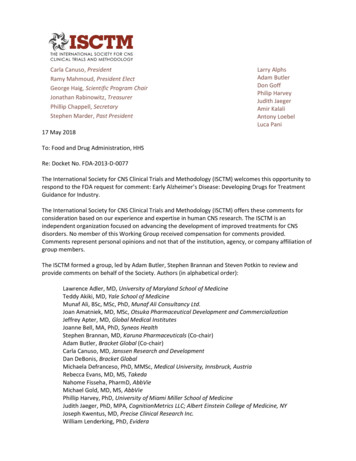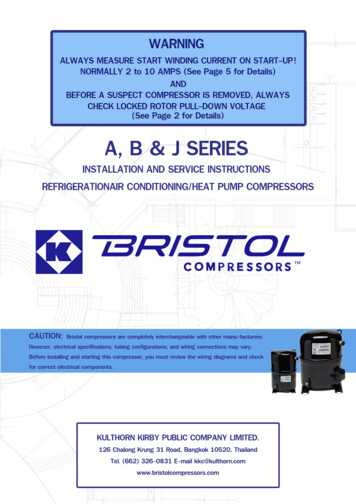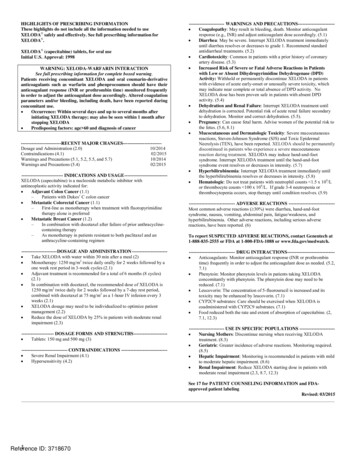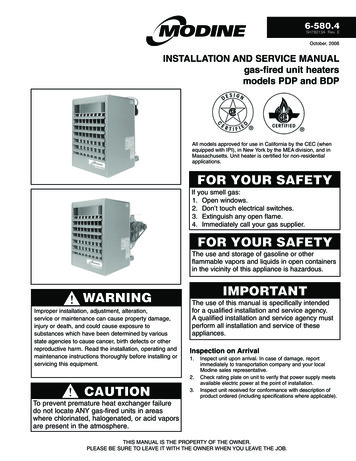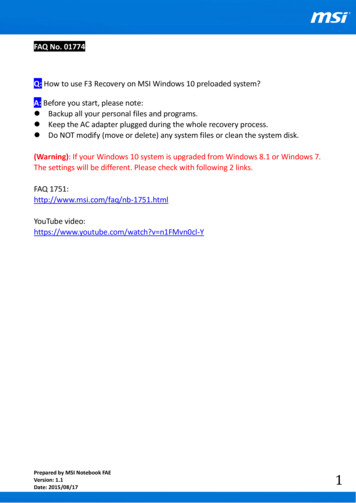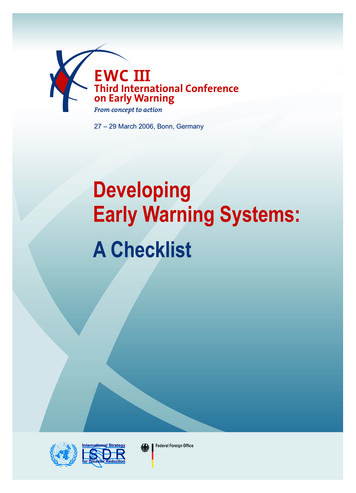
Transcription
EWC IIIThird International Conferenceon Early WarningFrom concept to action27 – 29 March 2006, Bonn, GermanyDevelopingEarly Warning Systems:A ChecklistewcIII CL cover rz druck.indd 123.05.2006, 11:08:29
FOREWORDEarly warning is a major element of disaster riskreduction. It prevents loss of life and reducesthe economic and material impact of disasters.To be effective, early warning systems need toactively involve the communities at risk,facilitate public education and awareness ofrisks, effectively disseminate messages andwarnings and ensure there is constant state ofpreparedness.In January 2005, the World Conference onDisaster Reduction adopted the “HyogoFramework for Action 2005-2015: Building theResilience of Nations and Communities toDisasters”. This included clear references to theimportance of early warning, and encouragedthe development of “early warning systems thatare people centred, in particular systems whosewarnings are timely and understandable tothose at risk ( ) including guidance on how toact upon warnings ( )” (para. 17, ii.d.9).The Third International Conference on EarlyWarning (EWC III) held in Bonn, Germany from27-29 March 2006 provided the opportunity topresent new and innovative early warningprojects and to discuss natural hazards andrisks around the world and how their impactscan be minimised through the implementation ofpeople-centred early warning. The presentdocument “Developing Early Warning Systems:A Checklist” was developed as a conferenceoutcome, to both inform and draw upon thediscussions and practical examples raisedduring the conference, and to support theimplementationoftheearlywarningcomponents of the Hyogo Framework forAction.The Checklist, which is structured around thefour key elements of effective early warningsystems, aims to be a simple list of the mainelements and actions that national governmentsor community organizations can refer to whendeveloping or evaluating early warning systems,or simply checking that crucial procedures arein place. It is not intended to be acomprehensive design manual, but instead apractical, non-technical reference tool to ensurethat the major elements of a good early warningsystem are in place.AcknowledgementsThe Checklist was initiated by the secretariat ofthe Third International Conference on EarlyWarning with the financial support of theGovernment of Germany. The project wasundertaken by consultant Alison Wiltshire,based at the ISDR Platform for the Promotion ofEarly Warning (PPEW) in Bonn. In addition toinformation gathered during the two and a halfdays of the conference, significant substantiveinput was received from organizations andindividuals involved in early warning anddisaster risk reduction, in the United Nationsinternational system and beyond.Appreciation and thanks are extended to allcontributors to this collective exercise, includingthe participants and project presenters of theThird International Conference on EarlyWarning who openly shared their views,concerns and practical experiences on how wecan achieve effective early warning systemswhich place people at their core.“Countries that develop policy legislativeand institutional frameworks for disasterrisk reduction and that are able todevelop and track progress throughspecific and measurable indicators havegreater capacity to manage risks and toachieve widespread consensus for,engagement in, and compliance withdisaster risk reduction measures acrossall sectors of society.”Hyogo Framework for Action 2005-2015:Building the Resilience of Nations andCommunities to Disasters, Paragraph 16.
WHAT’S INSIDEThis document aims to present a short, simplechecklist of basic elements, actions and goodpractices associated with effective earlywarning systems. It is intended to be a nontechnical reference tool rather than anextensive ‘how to’ list for the design of earlywarning systems.2. A checklist of practical actions to assistin developing, evaluating or refining anearly warning systemFor ease of use and practicality, an individualchecklist has been developed for each of thefour elements of early warning. An additionalchecklist has also been prepared on the crosscutting issue of governance and institutionalarrangements due to the importance of thisissue to the sustainability and cohesiveness ofeffective early warning systems.How to Use the ChecklistThe document is broken into two inter-relatedparts that should be read in order. The firstsection provides useful background informationand overarching issues important to earlywarning. The second part is a series ofpractical checklists of actions and initiativesthat should be considered when developing orevaluating early warning systems.Each of the checklists is grouped under aseries of major themes and includes a simplelist of actions or steps that, if followed, willprovide a solid basis upon which to build orassess an early warning system.1. Key elements of early warning, crosscutting issues and actors involved inearly warning“Much has been learnt from the creativedisaster prevention efforts of poorcommunities in developing countries.Prevention policy is too important to beleft to governments and internationalagencies alone. To succeed, it must alsoengage civil society, the private sectorand the media.”A brief section on the four elements of earlywarning: risk knowledge; technical monitoringand warning service; communication anddissemination of warnings; and communityresponse capability is included to emphasizethe major components that comprise aneffective people-centred early warning system,and why each is important.Kofi AnnanUN Secretary-GeneralIn addition to the four elements, a number ofcross–cutting issues that are critical to thedevelopment and sustainability of effectiveearly warning systems have been outlined.These include effective governance andinstitutional arrangements, a multi-hazardapproach to early warning, involvement of localcommunities and consideration of genderperspective and cultural diversity.International Decade for Natural DisasterReduction (IDNDR) Programme ForumGeneva, July 1999An explanation of the main actors involved inearly warning activities, and their roles andresponsibilities, is included to provide somecontext and further background to the list ofkey actors presented at the beginning of eachof the checklists.1
PEOPLE-CENTRED EARLY WARNING SYSTEMS1. The Key ElementsThe objective of people-centred early warningsystems is to empower individuals andcommunities threatened by hazards to act insufficient time and in an appropriate manner toreduce the possibility of personal injury, loss oflife and damage to property and theenvironment.A complete and effective early warning systemcomprises four inter-related elements, spanningknowledge of hazards and vulnerabilitiesthrough to preparedness and capacity torespond. Best practice early warning systemsalso have strong inter-linkages and effectivecommunication channels between all of theelements.Risk KnowledgeRisks arise from the combination of hazardsand vulnerabilities at a particular location.Assessments of risk require systematiccollection and analysis of data and shouldconsider the dynamic nature of hazards andvulnerabilities that arise from processes such asurbanization,ruralland-usechange,environmental degradation and climate change.Risk assessments and maps help to motivatepeople, prioritise early warning system needsand guide preparations for disaster preventionand responses.Four Elements of People-centred Early WarningSystemsSource: UN/ISDR Platform for the Promotion of Early WarningDissemination and CommunicationWarnings must reach those at risk. Clearmessages containing simple, useful informationare critical to enable proper responses that willhelp safeguard lives and livelihoods. Regional,national and community level communicationsystems must be pre-identified and appropriateauthoritative voices established. The use ofmultiple communication channels is necessaryto ensure as many people as possible arewarned, to avoid failure of any one channel, andto reinforce the warning message.Monitoring and Warning ServiceWarning services lie at the core of the system.There must be a sound scientific basis forpredicting and forecasting hazards and areliable forecasting and warning system thatoperates 24 hours a day. Continuous monitoringof hazard parameters and precursors isessential to generate accurate warnings in atimely fashion. Warning services for differenthazards should be coordinated where possibleto gain the benefit of shared institutional,procedural and communicationnetworks.Response CapabilityIt is essential that communities understand theirrisks; respect the warning service and knowhow to react. Education and preparednessprogrammes play a key role. It is also essentialthat disaster management plans are in place,well practiced and tested. The communityshould be well informed on options for safebehaviour, available escape routes, and howbest to avoid damage and loss to property.2
2. Cross-cutting IssuesInvolvement of Local CommunitiesPeople-centred early warning systems rely onthe direct participation of those most likely to beexposed to hazards. Without the involvement oflocal authorities and communities at risk,government and institutional interventions andresponses to hazard events are likely to beinadequate.There are a range of overarching issues thatshould be taken into account when designingand maintaining effective early warningsystems.Effective Governance and InstitutionalArrangementsWell-developed governance and opment and sustainability of sound earlywarning systems. They are the foundationsupon which the previously outlined fourelements of early warning are built,strengthened and maintained.A local, ‘bottom-up’ approach to early warning,with the active participation of localcommunities, enables a multi-dimensionalresponse to problems and needs. In this way,local communities, civic groups and traditionalstructures can contribute to the reduction ofvulnerability and to the strengthening of localcapacities.Good governance is encouraged by robust legaland regulatory frameworks and supported bylong-term political commitment and ance arrangements should encouragelocal decision-making and participation whichare supported by broader administrative andresource capabilities at the national or regionallevel.Consideration of Gender Perspectives andCultural DiversityIn developing early warning systems it isessential to recognize that different groups havedifferent vulnerabilities according to culture,gender or other characteristics that influencetheir capacity to effectively prepare for, preventand respond to disasters. Women and menoften play different roles in society and havedifferent access to information in disastersituations. In addition, the elderly, disabled andsocio-economically disadvantaged are oftenmore vulnerable.Vertical and horizontal communication andcoordinationbetweenearlywarningstakeholders should also be established.A Multi-Hazard ApproachWhere possible, early warning systems shouldlink all hazard-based systems. Economies ofscale, sustainability and efficiency can beenhanced if systems and operational activitiesare established and maintained within a multipurpose framework that considers all hazardsand end user needs.Information, institutional arrangements andwarning communication systems should betailored to meet the needs of every group inevery vulnerable community.Multi-hazard early warning systems will also beactivated more often than a single-hazardwarning system, and therefore should providebetter functionality and reliability for dangeroushigh intensity events, such as tsunamis, thatoccur infrequently. Multi-hazard systems alsohelp the public better understand the range ofrisks they face and reinforce desiredpreparedness actions and warning responsebehaviours.3
in countries that share a common geographicalenvironment. In addition, they encouragelinkages with international organizations andfacilitate effective early warning practicesamong adjacent countries.3. Key ActorsDeveloping and implementing an effective earlywarning system requires the contribution andcoordination of a diverse range of individualsand groups. The following list provides a briefexplanation of the types of organizations andgroups that should be involved in early warningsystems and their functions and responsibilities.International bodies can provide internationalcoordination, standardization, and support fornational early warning activities and foster theexchange of data and knowledge betweenindividual countries and regions. Support mayinclude the provision of advisory zational support necessary to aid thedevelopment and operational capabilities ofnational authorities or le, are fundamental to people-centredearly warning systems. They should be activelyinvolved in all aspects of the establishment andoperation of early warning systems; be aware ofthe hazards and potential impacts to which theyare exposed; and be able to take actions tominimize the threat of loss or damage.Non-governmental organisations play a rolein raising awareness among individuals,communities and organizations involved in earlywarning, particularly at the community level.They can also assist with implementing earlywarning systems and in preparing communitiesfor natural disasters. In addition, they can playan important advocacy role to help ensure thatearly warning stays on the agenda ofgovernment policy makers.Local governments, like communities andindividuals, are at the centre of effective earlywarning systems. They should be empoweredby national governments, have considerableknowledge of the hazards to which theircommunities are exposed and be activelyinvolved in the design and maintenance of ear
that disaster management plans are in place, well practiced and tested. The community should be well informed on options for safe behaviour, available escape routes, and how best to avoid damage and loss to property. 3 2. Cross-cutting Issues There are a range of overarching issues that should be taken into account when designing and maintaining effective early warning systems. Effective .
